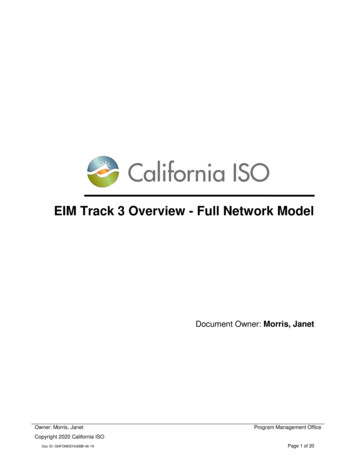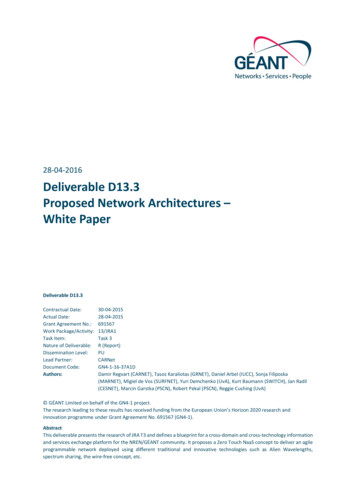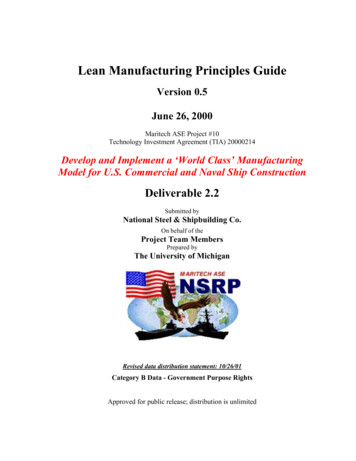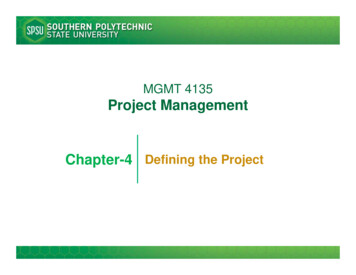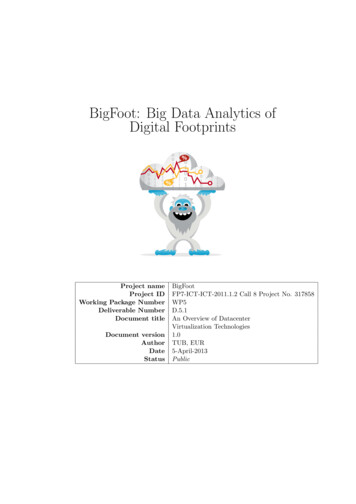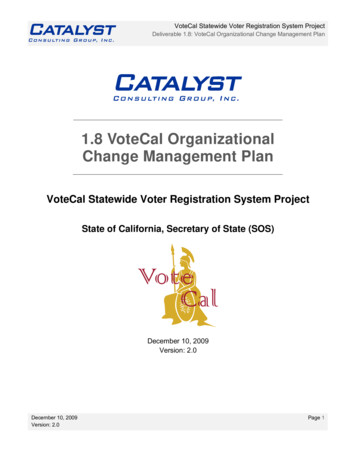
Transcription
VoteCal Statewide Voter Registration System ProjectDeliverable 1.8: VoteCal Organizational Change Management Plan1.8 VoteCal OrganizationalChange Management PlanVoteCal Statewide Voter Registration System ProjectState of California, Secretary of State (SOS)December 10, 2009Version: 2.0December 10, 2009Version: 2.0Page 1
VoteCal Statewide Voter Registration System ProjectDeliverable 1.8: VoteCal Organizational Change Management PlanAuthorsThis document was prepared by:ContributorsDon WestfallCatalyst Consulting Group211 West Wacker DriveSuite 450Chicago, IL 60606Kurt SchwartzCatalyst Consulting Group211 West Wacker DriveSuite 450Chicago, IL 60606Matthew BentonCatalyst Consulting Group211 West Wacker DriveSuite 450Chicago, IL 60606Kalyn FarrisCatalyst Consulting Group211 West Wacker DriveSuite 450Chicago, IL 60606Version ControlDateDocumentVersionDocument RevisionDescriptionRevision Author10/28/20091.0Draft Plan Submitted to SOS for ReviewKalyn Farris / Matthew Benton11/5/20091.1Revised Plan Submitted to SOS for ReviewKalyn Farris11/20/20091.2Revised Plan following Revised DEDKalyn Farris12/3/20091.3Revised Plan Submitted to SOS for ReviewKalyn Farris12/8/20091.4Revised Plan submitted to SOS for reviewKalyn Farris12/9/20092.0Final Plan Submitted to SOS for ReviewKalyn FarrisDecember 10, 2009Version: 2.0Page 2
VoteCal Statewide Voter Registration System ProjectDeliverable 1.8: VoteCal Organizational Change Management PlanTable of Contents1.Introduction .41.1Purpose and Objectives .41.2Scope .51.3Standards .61.4Assumptions, Dependencies, and Constraints.61.5Document Control.72.Roles and Responsibilities .83.Organizational Change Management Approach.103.1Overview of Approach .103.2Assess .113.3Analyze.133.4Plan .153.5Critical Success Factors and Guiding Principles .163.6Detailed Organizational Change Management Threads .173.6.1Project Management .173.6.2Project Team Alignment .183.6.3Change Management and Communications .183.6.4Workforce Transformation.193.6.5Training .203.6.6Implementation Support .204.Current Analysis of Organization Change Management Needs .225.Work Plan Overview .355.1Big Picture – Activities Across the Duration of the Project .355.2Focused View – Current and Next Phase .36Appendix A – OCM Planning Matrix.41Appendix B – Sample Organizational Readiness Survey Questions .43Appendix C – OCM Risk Level Maturity Model .45Appendix D – Anticipated Change Readiness Acceptance Levels .47Appendix E – VoteCal OCM Activities by Phase.51Appendix F– VoteCal OCM Activities Wall Chart .52December 10, 2009Version: 2.0Page 3
VoteCal Statewide Voter Registration System ProjectDeliverable 1.8: VoteCal Organizational Change Management Plan1. IntroductionThe VoteCal Project will provide the California Office of the Secretary of State (SOS) with a single,centralized voter registration database that will meet Help America Vote Act (HAVA) 2002requirements.Relative to other states, California’s HAVA implementation will present far fewer risks associated withorganizational change management than experienced elsewhere. SOS has chosen to implement abottom-up model, which by itself minimizes the changes required by county elections offices. Thebusiness model SOS implemented nearly ten (10) years ago under CalVoter I further lessen the effectsof HAVA compliance on the State, since the current CalVoter I system implements a bottom-up modelthat is conceptually similar to what will be implemented for VoteCal. The business model similaritiesbetween CalVoter I and VoteCal indicate that there will be less change for end users and otherstakeholders than if CalVoter I had not preceded VoteCal. Based on these factors, the VoteCal Projectestimates the change required under VoteCal to be very manageable.While the similarities in business models will lessen issues resulting from change, there are still anumber of changes to business process that will be required under VoteCal to achieve HAVAcompliance. In conjunction with business model and business process changes, other human-focusedtransition risks are likely. For example, SOS and county job roles/duties may change, new statewidepolicies may be required as a result of the technical or procedural changes, and new staff and staffinglevels may be required to support HAVA requirements.Collectively, these changes present a unique transition challenge to end-users, the SOS, counties, andElection Management System (EMS) vendors. To manage the human-focused transition risks andneeds, the VoteCal Project will initiate and conduct organizational change management (OCM)activities throughout the project’s lifecycle. OCM activities will be used to plan and facilitate a smoothtransition to the “to be” environment in order to increase the probability of a successful implementation.This document is Deliverable 1.8, the VoteCal Organizational Change Management Plan. It has beendeveloped to the specifications presented in Deliverable Expectation Document (DED) 1.8, VoteCalOrganizational Change Management Plan as reviewed by the Secretary of State (SOS).1.1 Purpose and ObjectivesThe OCM Plan is designed to guide the VoteCal Project’s actions and activities related toorganizational change management. The plan describes the approach the VoteCal Project will take toaddress the human-focused needs that will be encountered in preparation for and during the VoteCalSystem implementation. Each version of the OCM Plan (Deliverable 1.8, Deliverable 3.4, and thephase-based updates) will be progressively more elaborative and specific as to both the humanfocused needs and the activities designed to address these needs. The details of this evolution aredescribed in Section 3 of this document.The goals of the Organizational Change Management Plan are to: Define how organizational change management issues will be identified (e.g., readinessassessments) Define potential and/or common activities used to support organizational transition, and theirapplicability to the VoteCal ProjectDecember 10, 2009Version: 2.0Page 4
VoteCal Statewide Voter Registration System ProjectDeliverable 1.8: VoteCal Organizational Change Management Plan Present a high-level strategy for conducting change management strategy, workplacereadiness, and other organizational change management activities Complement the VoteCal Communications Plan (Deliverable 1.1) and the VoteCal SystemTraining Plan (Deliverable 2.10), as well as the SOS Communication Plan.The following are expected outcomes of a fully implemented OCM Plan. Project Team and SOS leadership actively participating in activities to build awareness amongstakeholders Project Team and SOS leadership that is aligned and committed to the initiative―speaking withone voice and delivering a consistent message Stakeholders who are aware and committed to the changes that will result from the initiative Future job roles and duties identified and defined, which appropriately reflect new businessprocesses Just-in-time training that is available to appropriate stakeholders Organizational models and structures that reflect the new business processes and otherchanges as a result of the implementationCommunications that reach all stakeholders and address all stakeholder issues and concernsLeaders and stakeholders who are engaged in the initiative and participating in discoverysessions, stakeholder meetings, and other activities where their input is neededTraining that appropriately reflects new business processes not just system changesPolicies, procedures, and strategies that are aligned and supportive of the new system andunderstood by responsible stakeholders1.2 ScopeThe OCM Plan is a high-level strategy document that defines the VoteCal Project’s organizationalchange management approach. The plan identifies the current understanding of human-focusedtransition needs that will be encountered during the VoteCal System implementation, and identifies theapproach that will be taken to address these needs.The plan identifies how the VoteCal Project Team (SOS and Catalyst) will identify and monitor OCMneeds through readiness assessments, risk reviews, and other feedback mechanisms. The OCMneeds identified will be limited to the primary VoteCal Project stakeholders, as identified below.Additional stakeholder groups exist for the VoteCal Project, but their concerns and information needswill be handled through the SOS Communication Plan, and not through this OCM Plan. VoteCal Project team members (SOS and Catalyst)SOS Elections Division staff (end-users)SOS IT Division staffCounty Elections staff (end-users)County IT staffEMS VendorsDecember 10, 2009Version: 2.0Page 5
VoteCal Statewide Voter Registration System ProjectDeliverable 1.8: VoteCal Organizational Change Management PlanThe OCM Plan also defines the response to the identified needs by defining planned and potentialOCM activities, tasks, and mechanisms that will be undertaken by the VoteCal Project Team (both SOSand Catalyst) to facilitate end-user transition and address other stakeholder needs. These activities aregrouped into the following six (6) OCM work threads: Project ManagementProject Team AlignmentChange Management and CommunicationsWorkforce TransitionTrainingImplementation SupportThe OCM Plan is a companion document to the Communications Plan (Deliverable 1.2) and theVoteCal System Training Plan (Deliverable 2.10), as well as a complement to the SOS CommunicationPlan. The OCM Plan includes components of the communications strategy and training strategy, toprovide a broad picture of the overall approach to transitioning end-users and stakeholders. The OCMPlan is not intended to supplement or supersede the communications or training plans. Details relatedto communications and training will be provided in these respective plans.The OCM Plan does not provide a detailed tactical or procedural approach to end-user and stakeholdertransition activities that will be conducted in every phase of the VoteCal Project. Instead, the plan isstrategic in nature, creating a framework and guide for the VoteCal Project’s OCM activities. Asidentified in Section 3: Organizational Change Management Approach, an Organizational ReadinessAssessment will be conducted early in the Design phase, as well as subsequently be reviewed andupdated in each phase. The results of this assessment will serve to guide the prioritization and scopingof the activities in each work thread. A list of potential activities can be found in Section 4: DetailedOrganizational Change Management Threads, with indications of which are mandatory vs.discretionary, and how decisions will be made as to which to include.1.3 StandardsWhile there are no recognized industry standards for organizational change management, businesstransformation, communication, and training, the methodology used for the VoteCal Project is based onsound and proven organizational change management best practices and the experience of theCatalyst Team.1.4 Assumptions, Dependencies, and ConstraintsThe OCM Plan was developed based on the following assumptions. Limited business process changes will be req
centralized voter registration database that will meet Help America Vote Act (HAVA) 2002 requirements. Relative to other states, California’s HAVA implementation will present far fewer risks associated with organizational change management than experienced elsewhere. SOS has chosen to implement a bottom-up model, which by itself minimizes the changes required by county elections offices. The .



